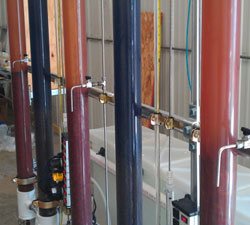EPA Technology Available for Licensing: Biological Filter for Oxidizing Ammonia in Drinking Water

Inventor: Darren A. Lytle
Owned by EPA
Federal Technology Transfer Act (FTTA) staff: Contact us if you are interested in learning more about how to license this technology.
Summary of the Technology
This technology is a treatment system for drinking water with elevated levels of ammonia. It combines aeration and biological filtration to oxidize excessive levels of ammonia in drinking water.
At the same time, the technology avoids nitrification in the distribution system and other problems associated with the presence of ammonia. The process converts ammonia in source water to nitrate by:
- Passing water through a packed column containing granular media (gravel) as packing.
- Introducing air through a diffuser at the bottom of the packed column to maintain the water saturated with oxygen throughout the column.
- Establishing colonies of bacteria that convert ammonia to nitrate.
- Producing treated effluent water from the column that is free of ammonia and nitrite.
Background
Ammonia occurs naturally in some ground water, or is added to water to form chloramines in drinking water distribution systems. Many regions in the U.S. have excessive levels of ammonia in their source waters. For example, farming and agriculture in the Midwest contribute to relatively high levels of ammonia in many ground waters.
Although ammonia in water does not pose a direct health concern, nitrification of significant amounts of excessive ammonia may.
The oxidation of ammonia to nitrite, and then nitrate, is a biological process referred to as nitrification. Nitrification in drinking water distribution systems disrupts the biological stability of the distribution system, causing water quality problems. Specifically, nitrification in a drinking water distribution system may lead to:
- Potential corrosion problems
- Oxidant demand
- Excessive biofilm growth
- Taste and odor complaints
- Elevated nitrite and nitrate levels

How the Technology is Different
Physicochemical methods for ammonia removal, such as ion exchange, are able to remove ammonia to varying degrees. Biological approaches may be the most efficient and cost effective, however, and do not produce undesirable waste streams. Biological nitrification is a two-step, aerobic, microbiological process:
- Oxidation of ammonia (NH4) and oxygen (O2) into nitrite; followed by
- Oxidation of the nitrite into nitrate
The complete process takes approximately 4.5 mg of O2/mg of NH4-N in the water. Aeration is a necessary feature of any biological ammonia treatment system. The traditional approach of aeration followed by biologically-active filtration, however, is limited.
The amount of oxygen that can be added to the water is limited by the saturation of oxygen in water. This in turn limits the amount of ammonia that can be treated. In response to this challenge, EPA developed and patented this innovative approach to introduce oxygen to the treatment system to remove ammonia.
EPA's ammonia biological treatment system was successfully piloted for over a year at a small community in Iowa. At the time of the study, the test community did not have a centralized water treatment or a drinking water distribution system. Following extensive flooding to the region in 2008, the community decided to build the necessary infrastructure to provide potable drinking water. Because the ground water at the site had low oxygen (3.6 mg O2/L) and elevated ammonia of 3.3 mg N/L as well as reduced iron of 0.82 mg/L, EPA's treatment system was ideal.
The pilot successfully treated all of the source water ammonia. The community used data from the pilot to define design and operating parameters. EPA wrote a final report about the Palo ammonia water treatment pilot project, and the community built a full-scale treatment plant. EPA conducted other pilot projects in the Midwest and Southeast.
